INTRODUCTION
Tonsillitis refers to inflammation of the pharyngeal tonsils. The inflammation may involve other areas of the back of the throat including the adenoids and the lingual tonsils (areas of tonsil tissue at the back of the tongue).There is several variations of tonsillitis: acute, recurrent, and chronic tonsillitis and peritonsillar abscess.

YOGA AND TONSILLITIS
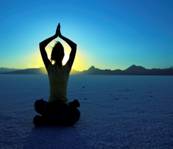
YOGA POSES FOR TONSILLITIS
Rabbit Pose
Yoga Rabbit pose is the ultimate spinal tension tamer. It can be perform after doing child pose. This pose helps bring blood to your brain, massage your thyroid and compress the throat, which also massages the lymph nodes. This helps to cure insomnia, depression, colds, sinus, tonsillitis, laryngitis, allergies and glandular defects, compresses thyroid, balances hormones, improves flexibility of scapula, and stimulates nerves behind eyes.
Corpse Pose
The Corpse Yoga Pose is considered as a classic relaxation Yoga Pose and is practiced before or in between Asanas as well as a Final Relaxation. While it looks deceptively simple, it is actually difficult to perform. Learn more on how to do it with the help of this article.
Triangle Pose
In Hindu art, the triangle is a potent symbol for the divine principle, and it is frequently found in the yantras and mandalas used for meditation. The Trikonasana or Triangle Pose concludes the Yoga Postures in our basic session.
Lion Pose
The pose of the roaring lion (whose Indian name is original Simhasana) yoga is suitable for people of all ages and types (old and weak including) because it is relatively easy to perform. The pose sometimes referred to as Bhairavasana. The pose gets its name because the face of the person performing the looks on the face of a roaring lion or fierce (Simha Mudra gesture or facial lion) because of the open mouth and tongue extended.
Fish Pose
Doing the Fish Pose relieves stiffness of the neck and shoulder muscles and improves flexibility of your spine. It is the counter-pose of the Shoulder stand. Hold the Fish Pose for at least half the amount of time you spent in the Shoulder stands in order to balance the stretch.
YOGA ASANAS FOR TONSILLITIS
PARYANKASANA
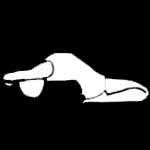
Paryanka means a bed, couch or sofa. This asana is a continuation of Supta Virasana. In it the body resembles a couch, hence the name.
Steps
• Sit in Virasana
• Exhale and recline on the back. Let the neck and the chest and arching the back up rest only the crown of the head on the floor. No part of the trunk should be on the floor.
• Bend the arms at the elbows. Hold with the right hand the left upper arm near the elbows and with the left hand the right upper arm near the elbow. Rest the folded arms on the floor behind the head.
• Stay in the pose for a minute with even breathing.
• Inhale, rest the trunk and d neck on the floor, release the hands and sit up in Virasana.
• Then straighten the legs one by one, lie flat on the back and relax.
SIMHASANA
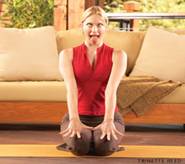
The Roaring Lion Posture (whose original Indian name is Simhasana) in Yoga is suitable for people of all ages and types (including old and weak) because it is relatively easy to perform. The posture is sometimes referred to as Bhairavasana.The posture gets its name because the face of the person performing it resembles the face of a Roaring Lion (Simha Mudra or Lion Face Gesture) because of the open mouth and extended tongue.
Steps
• Kneel down on the ground and place your body weight on your knees, calves and heels with the toes pointing back.
• Keep your head and spine erects with the knees about 6-12 inches apart.
• Press your palms on the respective knees with the fingers extended straight. This is the Thunderbolt Posture.
• Open your mouth fully. Exhale through your nose and mouth, and simultaneously extend your tongue comfortably out of your mouth curving it toward the chin. Hold your breath with the abdomen pulled in. Widen your eyes, bare your teeth and stretch your facial muscles so that your face looks terrifying.
• Remain in this final posture for about 10 seconds or your breakpoint.
MATSYASANA
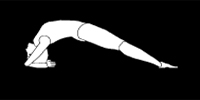
The word 'Matsya' would mean fish. This posture is named after one of the incarnation of Lord Vishnu who assumed the form of a fish. Hence the name 'Matsyasana' or the 'Fish Pose'.
Steps
• Sit in Padmasana (Lotus pose).
• Lie with your back flat with the legs placed on the floor.
• Breathe out and arch the back, lifting the neck and the chest. Taking the head back, rest the crown of the head on the floor. Increase the back arch by dragging the head further back by holding the crossed legs.
• Remove the hands from the legs. Flex the arms and hold the elbows resting the forearms on the floor behind the head.
• Stay in this position for about half a minute to a minute with deep breathing.
• Rest the back of the head on the floor and lie down flat on the back. Breathe in and get back to Padmasana to release the legs and relax.
• Recross the legs the other way and repeat the pose the same way for the same length if time.
• If it is difficult to perform the 3 and 4 position, lie down flat on the back and have the hands outstretched straight over the head.
MAKARASANA
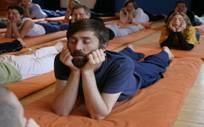
Steps
• Lie in Saashtaangasana position.
• Spread the legs apart, so that the feet are at least 18 to 24 inches from one another..
• The heels should oppose each other with the toes pointing away.
• The thighs, abdomen and chest should rest on the ground and fold your arms so that they form a triangle under the face. The palms should clasp your opposite shoulder.
• The head rests on the triangle formed by the elbows and the shoulders.
• While breathing deeply stay in this position for at least 10 to 15 minutes.
TRIKONASANA
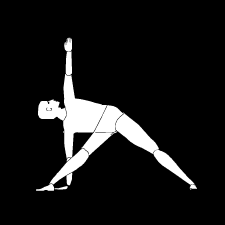
This asana makes the spine flexible and gives good exercise to the lateral area. It also vitalizes the liver, pancreas and kidneys, exercises the side muscles and increases the flexibility of the hip joints and waist.
Steps
• Stand straight, feet apart and arms on the sides, palms facing and touching the thighs.
• While inhaling, raise your right arm slowly up to shoulder level, palm facing down with the elbow straight.
• Now turn the palm upwards and raise the hand so that it is in a straight line, touching the ear.
• While exhaling, bend as far as possible to the left. This is the final position of Trikonasana.
• Maintain it for a few seconds and return to normal position gradually.
• The same is to be done on the other side. This completes the process. The lateral stretch should be felt.
ASTROLOGY
Yoga is the primary level which consists of bodily exercises to build a ground for Meditation. The word yoga had been derived from the Sanskrit word yuj which means to join to unite to balance or to integrate. Yoga is a system of exercises for the mental and physical well being. It combines stylized poses with deep meditation and breathing. According to Patanjali, within the human body there are channels called Nadi and centers called chakra. According to astrological reports for yoga asanas the above mentioned asanas are said to be effective for those who come under the following zodiac sign.
• TAURUS